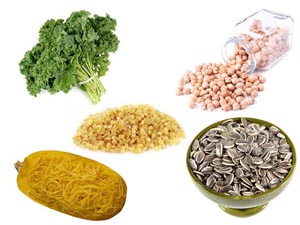With the hectic hustle and bustle of daily life — managing family, career, home and more — it is no wonder that creativity in the kitchen can fall to the wayside. To help people get out of a food rut and eat healthier this year, a dietitian from the University of Alabama at Birmingham (UAB) suggests adding five foods to the grocery cart.
 As defined by the 2010 Dietary Guidelines for Americans, a healthy eating pattern emphasizes nutrient-dense foods and beverages: vegetables and fruits; whole grains; fat-free or low-fat milk and milk products; seafood, lean meats and poultry; eggs, beans and peas; and nuts and seeds.
As defined by the 2010 Dietary Guidelines for Americans, a healthy eating pattern emphasizes nutrient-dense foods and beverages: vegetables and fruits; whole grains; fat-free or low-fat milk and milk products; seafood, lean meats and poultry; eggs, beans and peas; and nuts and seeds.
According to Lindsey Lee, R.D., clinical dietitian with EatRight by UAB Weight Management Services, there are numerous often-ignored foods that fit the bill for healthier eating.
“There are many foods that, while unfamiliar to some, are readily accessible in most grocery stores and can really expand a person’s daily diet without expanding their waistlines,” Lee explained.
Here are five foods Lee recommends:
Bulgur: This whole-wheat product is a good substitution for rice or potatoes that has a mild, nutty flavor and chewy texture. It is packed with eight grams of fiber and six grams of protein per cup, and it clocks in at only about 150 calories. It is also a good source of vitamins and minerals; particularly B vitamins and manganese. It can typically be found in the same aisle as rice and beans.
“The fiber and protein in whole-wheat products like bulgur help keep us feeling full throughout the day,” Lee said. “Bulgur has a fairly low glycemic index, so it does not dramatically raise blood sugar like refined flour products like white potatoes or white rice.”
Lee's recommended foods:
|
Chickpeas (garbanzo beans): Chickpeas, also called garbanzo beans, are healthy, versatile and inexpensive legumes that are very easy to prepare. They can even be consumed right out of the can. One cup of chickpeas has 13 grams of fiber, 15 grams of protein and three grams of healthy fat. They also have antioxidant properties and are loaded with vitamins and minerals. They can be found in the canned foods section or with the dried beans. Lee suggested eating legumes like these three to four times per week.
“Most of the fiber in chickpeas is insoluble fiber, which is great for digestive health,” Lee explained. “Individuals who eat them typically have better blood sugar regulation since chickpeas are so high in fiber and protein.”
Kale: Kale is a leafy green vegetable that is loaded with antioxidant vitamins A, C and K, and it is a good source of essential minerals like copper, potassium, iron, manganese and phosphorus. A cup of this vegetable, which can be found in the produce department, is only about 40 calories.
“The vitamins in kale are associated with anti-cancer health benefits, and the fiber in kale helps bind cholesterol in the body, which improves heart health,” Lee said. “Individuals should include cruciferous vegetables like kale in their diet at least four to five times per week.”
Spaghetti squash: Spaghetti squash is the low-carbohydrate alternative to spaghetti pasta; the inner flesh of this squash pulls into strands, resembling the popular pasta. A one-cup serving of spaghetti squash has 10 grams of carbohydrates as compared to about 45 grams in one cup of pasta or rice. One cup has only 42 calories and offers important health benefits.
“Like all vegetables, spaghetti squash provides the body with essential vitamins and minerals like vitamin A, B-vitamins and manganese,” Lee said. “And it’s very versatile; you can bake or steam your spaghetti squash before adding it to recipes, or eat it as a side dish with your favorite lean meat.”
Spaghetti squash can typically be found in the vegetable section year-round.
Sunflower seeds: Sunflower seeds are generally less expensive than other nuts, and they offer many of the same health benefits as popular choices like almonds and walnuts. A quarter cup of sunflower seeds has three grams of fiber and six grams of protein. Unsalted sunflower seeds contain healthy fats, but they are high in calories at about 280 per quarter cup. Lee recommends keeping to one portion. Sunflower seeds are a good source of copper, vitamin E, selenium and manganese. Shelled, unsalted sunflower seeds can be found in the nut section, and they can be added to salads or yogurt, or eaten plain.
“The vitamin E in sunflower seeds offers significant anti-inflammatory effects; and it is an antioxidant, so it also plays an important role in the prevention of cardiovascular disease,” Lee said.